Print History: The Printer as Print Historian - Bapurao Naik
A trained printer who rose from the lowest rungs of the print trade, Bapurao Naik also developed a keen sense of history in connection to his profession. Through his books, he made seminal contributions to the history of print in India. Moreover, his writings on the revolutionary changes in printing technology happening in the second half of twentieth century are now valuable historical documents
30 Apr 2023 | By Murali Ranganathan
In India, for centuries, printing was a trade which could be learnt only at a printing press. Neither were there any educational institutions which taught this trade nor were there any formal apprenticeship systems. Most training on the job was informal and unstructured. The novice printer had to understand the intricacies of a trade which spanned both the arts and the sciences by observing and emulating the master printer at work. Advancement was slow and unpredictable. At best, he could pick up only one aspect of the print trade, say, as a text compositor or as a pressman. The more ambitious among them had to establish their own printing presses to advance their careers. However, all this began to change in the twentieth century with the establishment of polytechnics and colleges where printing was taught. By the 1930s, a system of apprenticeship had been introduced in printing presses owned by provincial governments in India. This led to the creation of a cadre of master printers who could lead the innovations in typography and printing techniques which would be required in a newly independent India.
Bapurao Naik (1920–1985) was one of the beneficiaries of this new system of education in print technology. Naik completed his schooling in his native town of Vengurla, situated in the south Konkan region of Maharashtra, before moving to Mumbai, the land of opportunities. As a sixteen-year-old boy with little support from his family, he had to immediately look for employment to sustain himself. Fortuitously, in 1936, he spotted an advertisement issued by the government of the Bombay Presidency on behalf of its printing department in Mumbai inviting applications for a five-year apprenticeship in printing. The practical training would be supplemented by a formal education course conducted by the Victoria Jubilee Technical Institute, then the premier institute for engineering and technology in western India. After five years of apprenticeship and training, a diploma in printing would be awarded. Naik was selected as one of the print apprentices and, in 1941, he became a qualified printer. At the end of his course, he joined the bottom rung of the managerial cadre in the Government Central Press at Mumbai and embarked on a career which was to last over three decades. As a print practitioner, Naik was conversant with the innumerable issues which Indian printers had to face, especially while printing Indian scripts. And it was his quest for solutions to these problems which led to his investigations in print history.
Paper
By the 1940s, the Marathi publishing world had matured enough to support the existence of numerous monthly and fortnightly magazines catering to a wide variety of interests. The printing fraternity could look forward to issues of Mudran Prakash, a magazine published from Pune. Not only did it publish articles related to the latest development in print technologies, it also contained essays connected with the history of printing and publishing in India. Bapurao Naik seems to have been one of the subscribers to the magazine. When Naik sent a critique of an essay in Mudran Prakash to its editor, he was invited to write for the journal.
Even as he was undergoing an intensive five-year course in print technology, Bapurao Naik seems to have developed a sensitivity towards the historical aspects of printing. This combined with a natural flair of writing laid the foundation for Naik to become a man of letters. After his first article appeared in Mudran Prakash, Naik wrote an article on the history of paper production in India. This article was published in 1939 by Chitramayajagat, arguably the most popular Marathi magazine of its time. This led to a series of articles on ‘Paper in India’ which covered both historical and contemporary aspects. In 1942, these articles were collected and published in the form of a book titled Kagad. Thus, at the age of twenty-two, Bapurao Naik was a published author. A part of this book was translated into Hindi and published as Kagaz. Much later, in 1982, Naik updated the Marathi book and published a revised edition.
In this book, Naik did not restrict himself to the historical aspects of the use of paper and its production in India. He was equally concerned about the contemporary situation in India, where large quantities were imported from Europe, Japan and China. India, on the verge of independence from colonial rule, was trying to transition from traditional handmade paper and develop its own paper manufacturing capabilities. Besides examining paper manufacturing techniques from different raw materials, Naik also considered other aspects of paper, likes its chemistry, quality control, watermarks. Naik also wrote a chapter on Indian handmade paper and the reasons for its dwindling fortunes. Besides being the first book on paper in Marathi, it was also very comprehensive.
This simultaneous engagement with the past and the present, and what it meant for the future, proved to be a template for all the print history writings of Bapurao Naik. In each of his books, Naik, as a master printer with one leg in the pressroom and another in the pre-press section, was well positioned to explore the past and envisage the future.
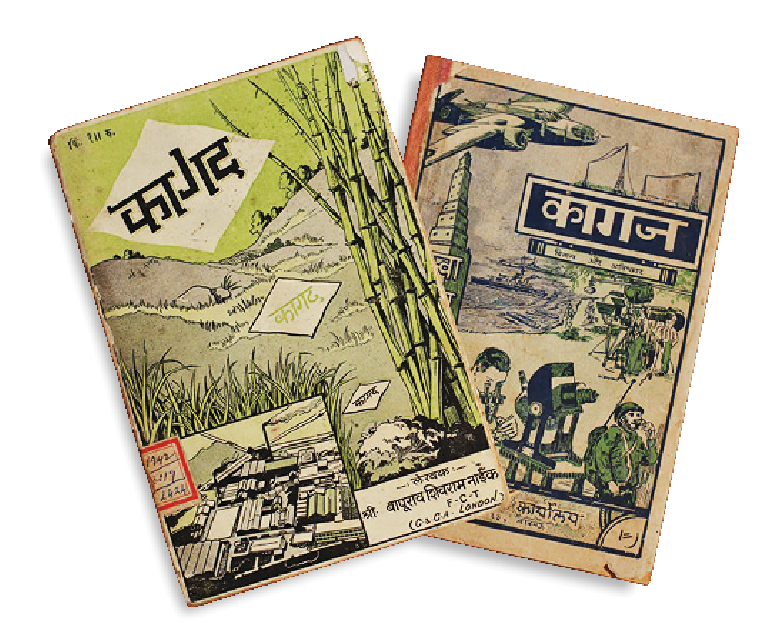
Marathi and Hindi editions of Kagad (1942)
Typography
The typography of Indian scripts had been an area of innovation and constant improvement from the start of the nineteenth century when printing in Indian languages began to slowly gather steam. Of all these scripts, Devanagari was perhaps most important because of its usage across a large swathe of north India. After Marathi adopted Devanagari, with some modifications, for printing instead of Modi, its area of influence increased further. Much of the research on Indian typography focussed on Devanagari. When hot metal composing companies like Monotype and Linotype began to consider the Indian market, they first chose to implement the Devanagari script. When phototypesetting was being developed, Devanagari was the first Indian script to be adapted for this technology.
After India got independence in 1947, printing in Indian languages increased considerably. Many of the provincial governments began printing their official transactions in their local languages. As the volume of printing increased, the pressure to develop more efficient and elegant typographical models increased. In response to these pressures, print practitioners and type designers came up with various solutions and suggestions. While many of them fell by the wayside, quite a few were accepted by the print industry. But perhaps the most important player was the Bombay Government which decided that standardization of print and typographical parameters were a pressing need. In 1959, it formed an Official Language Committee whose remit was to suggest “changes in typewriters and printing presses, relating to mechanical contrivances such as typewriters, Monotype, Linotype and teleprinters.” This committee recommended that an expert committee be formed to “go into the question of standardising the keyboards for typewriters and mechanical composing machines.”
Bapurao Naik had risen through the ranks of the government printing cadre after stints at numerous government presses in the Bombay province including the jail presses at Pune (Yerwada) and Nagpur, and the Baroda State Press. In the early 1950s, he was sent to London for further training in modern print technology at the London School of Printing. By the early 1960s, he had been designated Deputy Director, Government Printing and Stationery with oversight of all the presses operated by the government of Maharashtra. By virtue of his official position as well as his expertise in the subject, Naik was a key member of the expert committee which was constituted in 1962 by the government of Maharashtra to reform the typography of Devanagari.
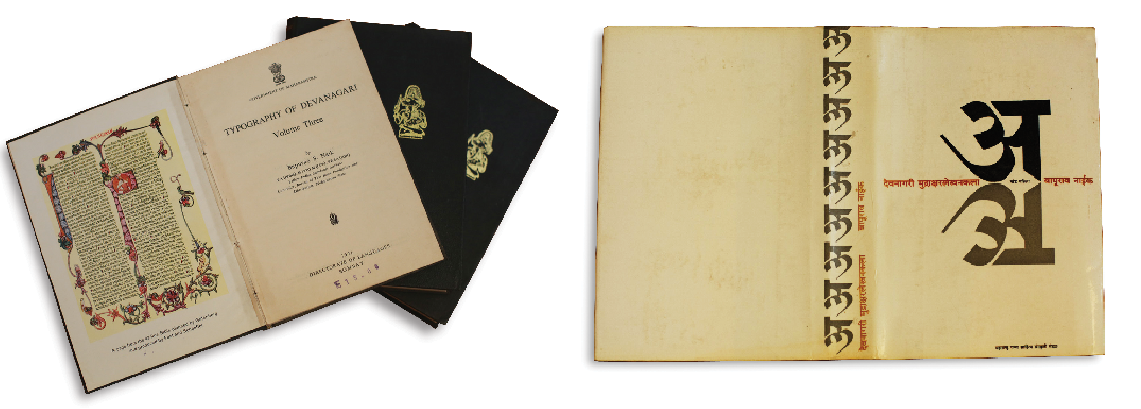
Typography of Devanagari (1971) and its Marathi translation (1982)
Devanagari.
Bapurao Naik was given the task of understanding the innumerable initiatives and developments in Devanagari typography made in the previous two centuries. This study would serve as the basis for suggesting reforms in the typography of Devanagari. This would impact not just traditional letter press composing and hot metal composing using Monotype and Linotype; it would also address issues related to the new technique of phototypesetting. The output of his study took the form of a three-volume monograph titled Typography of Devanagari which exhaustively surveys the past and takes cognizance of all the contemporary efforts at studying Devanagari. It also uses techniques such as grapheme analysis of Devanagari to rationalize the number of type sorts in a typical font. As its preface asserted, “It can be fairly claimed that such a comprehensive study of the problems of the Devanagari script and of the work of script reformers is being presented in a Monograph for the first time. A perusal of the Monograph will show the large amount of research that has gone into its preparation.” If this very useful book had been astutely copy-edited and Naik had been more judicious in reproducing the work of other writers, it could have been classified as a minor classic.
A very important offshoot of this project was the collection of printing incunabula and early Indian printed books which Bapurao Naik put together. The font specimens and title pages of these books were used to illustrate Typography of Devanagari. In 1982, Naik himself translated the book into Marathi under the title Devanagari Mudrakshar Lekhankala.
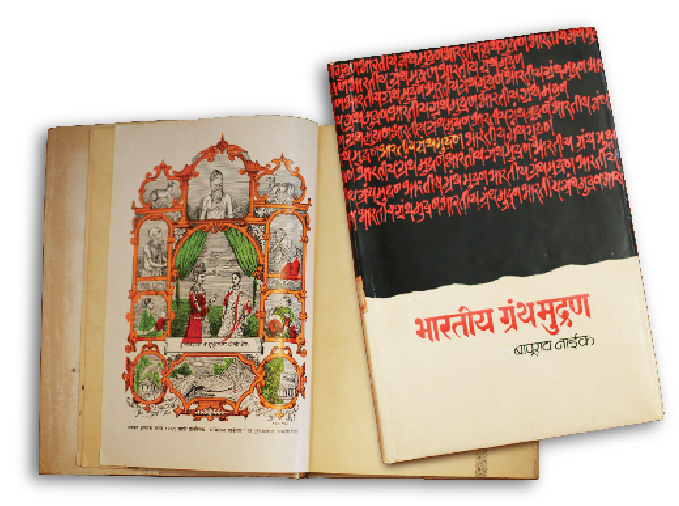
Bharatiya Granth Mudran (1980)
Book printing in India
In 1971, Bapurao Naik delivered a series of three lectures on ‘Book Printing in India’ to an august audience of printers, typographers, editors, journalists and intellectuals in Pune. As was his wont, these three lectures investigated the past, present and future of the business of printing books in India. In the first lecture, after a brief review of Indian language printing in Europe and the growth of printing in India until the early decades of the nineteenth century, he focussed on the production of books in the Marathi language in Mumbai and Pune. The second lecture focussed on the technical aspects of book printing and production, especially pre-press activities like text composition. He also highlighted the necessity for more research in practical typography to make the process of composition simpler and faster. The third lecture focussed on the business aspects of printing books, especially from the perspective of small-scale printers. He also highlighted the trade-offs between publishers and printers.
These lectures were published under the title Bharatiya Granth Mudran in 1980, perhaps the first book in Marathi to exhaustively consider the printing of books and their history. Though it starts by reviewing the early history of book printing in India, it is largely concerned with books printed in the Marathi language. It is certainly a milestone in the book history of India.
As the Maharashtra government began focussing on printing and publishing textbooks for schools, they created a monopoly for themselves in this important sector of print in 1967. Bapurao Naik was designated Controller of Textbooks, a post he held for the next eight years. The task of designing and commissioning a series of graded textbooks in numerous subjects in four to five languages was challenging. He also had to find solutions to annually print over a hundred different textbooks with extremely large print runs in a time-bound manner. In Bharatiya Granth Mudran, he also explores the history of school textbooks in India, especially those printed in Bombay and Pune. This was a subject he had explored in 1973 through an article titled Pathyapustakanchi Janmakatha (The Origin of Textbooks).

Priolkar ani Mudransamshodhan (1976)
The Historiography of Marathi Print
Bapurao Naik was an associate of AK Priolkar, arguably the pioneer print historian of India, whose landmark book The Printing Press in India was published in 1958. After Priolkar died in 1973, Naik paid tribute to him in the form of a slim book titled Priolkar ani Mudransamshodhan [Priolkar and Print History]. Using Priolkar as a pivot, Naik traces the emergence of a tradition of Marathi print history to 1913 and maps its progress over the decades, evaluates the contributions made by Priolkar to print history in Maharashtra, and contrasts them with those made by his contemporaries. The book can be considered a pioneering attempt in print historiography.
Epilogue
Bapurao Naik was a multi-faceted personality whose interests and activities extended far beyond printing and print history. He had a keen interest in theatre which manifested itself in numerous ways: organising theatre festivals, conducting theatre magazines, researching theatre history, studying and designing performance spaces, lighting design for plays, and much more.
Naik also taught print technology and the business of printing for many years at the Government Institute of Printing Technology in Mumbai which has been established in 1956 to provide professional training to budding printers. He also wrote extensively in the printing industry journals on topics of contemporary relevance.
As a person with a bilingual fluency, Naik could write just as well in English as he could in Marathi. Unique among his peers as a printer who had a deep interest in the historical development of print, Bapurao Naik could channelize this interest into three books related to print history. If his articles on the changes and challenges which the Indian printing industry faced between the 1950s and 1980s are collected together, they would constitute a valuable source of print history for that period.









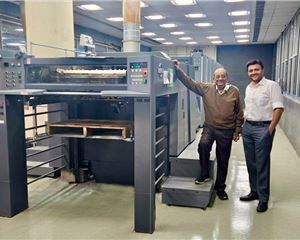

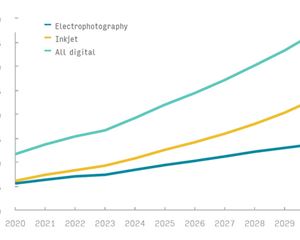
 See All
See All